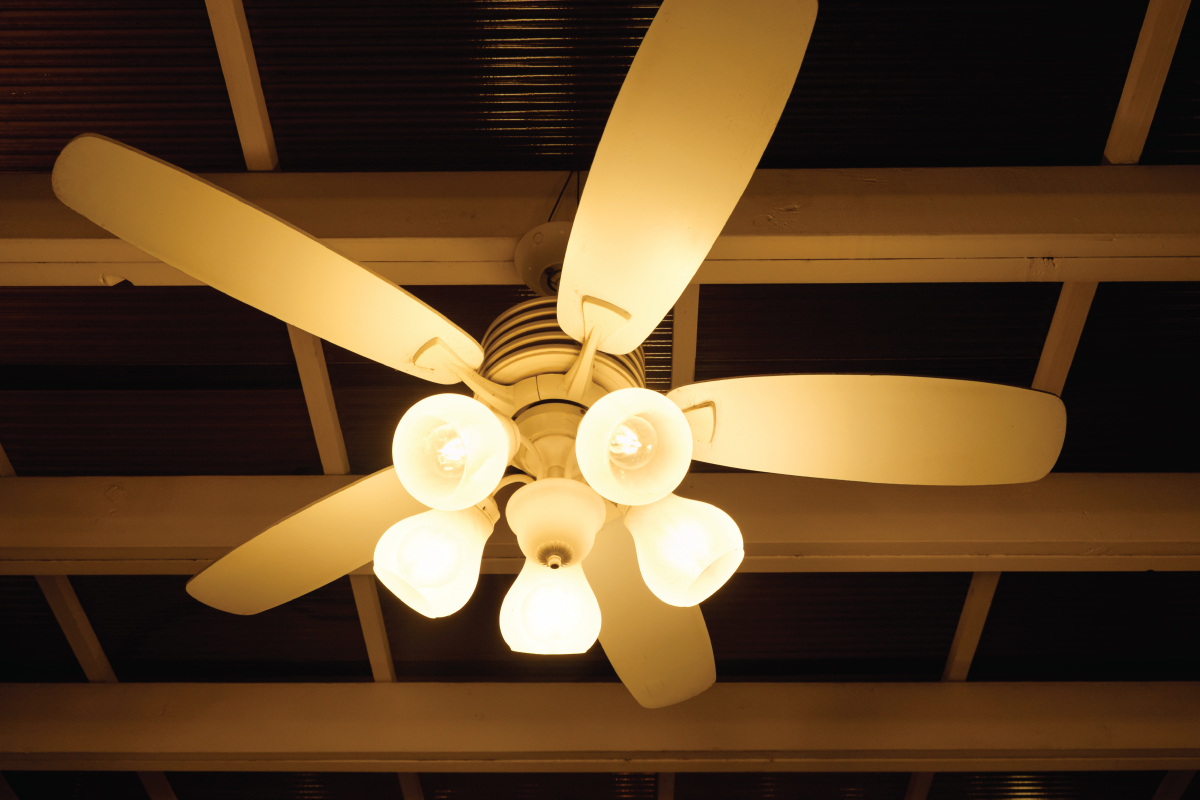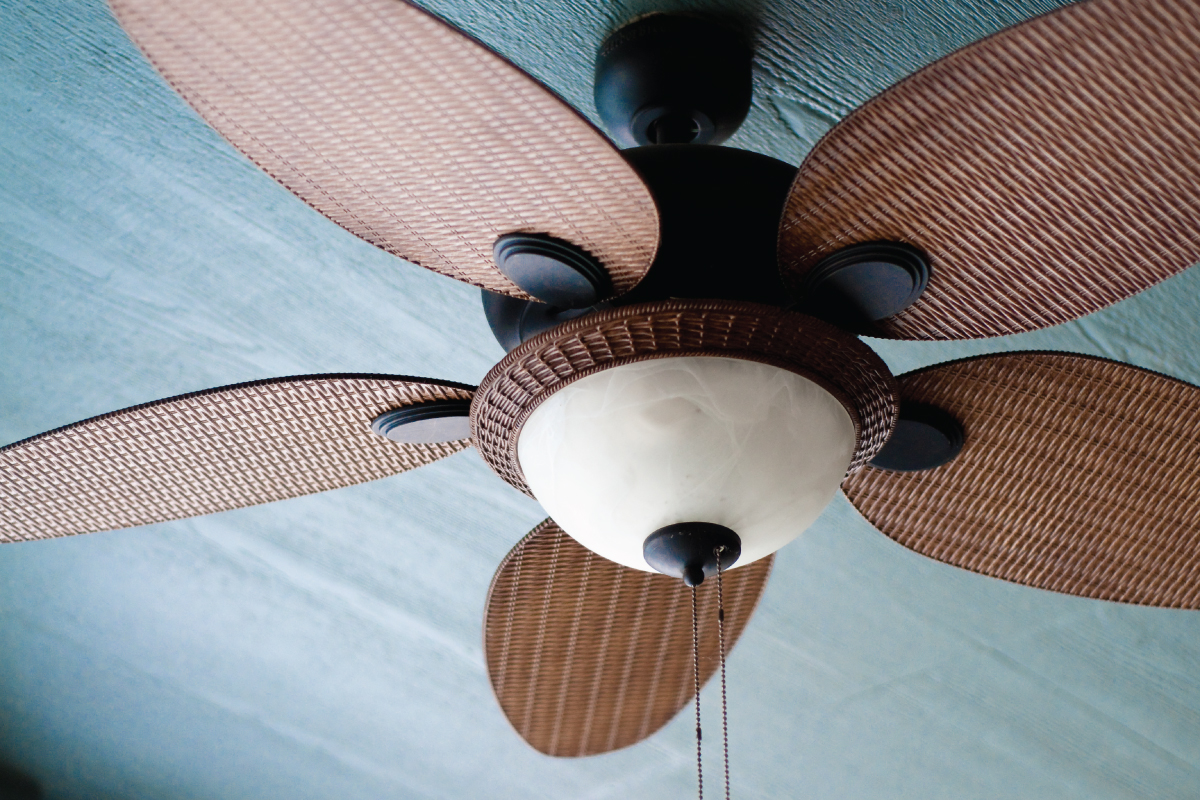Ceiling fans can add a touch of elegance to your home decor as well as help you save money on your energy bills all year-round. A common question regarding the maintenance for ceiling fans is whether or not they need to be oiled as part of their maintenance regimen. Well, we've created this guide to answer this question for you.
Newer model ceiling fans typically do not require oil because they are built with sealed, self-lubricating ball bearings. If your ceiling fan was made before 1970, likely it will need to be oiled on an annual basis. Older ceiling fans require oil because they are typically built with cast iron or metal bearings and other components requiring lubrication to reduce the friction generated by moving parts. A few common ceiling fan brands and models that require oil include the following:
- Evergo Leslie-Locke
- Kenroy
- The Hunter Original
- Montgomery Ward
Let's talk a little more about why some fans need oil, and some don't. We'll show you how to determine whether to oil your fan and what types of oils are appropriate. Finally, we'll walk you step-by-step through how to oil a ceiling fan, even while it is mounted.

Do Ceiling Fans Need To Be Oiled?
Older model fans were not built with sealed ball bearings, and over time the friction generated from the movement of the bearings gradually wears the bearings down, leading to rust and corrosion. At a certain point, this causes the fan to begin malfunctioning. To prevent this, motor oil is used to lubricate the bearings to resume constant, smooth movement.
Many newer model ceiling fans are designed to be maintenance-free, for the most part. They'll more than likely come with ball bearings that are double-sealed and self-lubricating--which means that they'll rarely require an oil application. Some older classic ceiling fan models can come with refurbished motors that include sealed ball joints, thus removing the need to apply fan oil to the motor.
Ceiling fans that are self-lubricating, in some circumstances, may still require an oil application. If the fan is near the end of its lifespan or has bearings that have become caked up with dirt, it may begin to make squeaking, grinding, or clicking sounds during its operation. This commonly occurs when fans are frequently used or are located in smoky or dirty conditions.
To determine whether your ceiling fan requires oil, it's best to refer to the manufacturer's instruction manual that came with the fan when you purchased it. If you've lost or misplaced the manual, you can simply go to the manufacturer's site or possibly find the manual via an online search.
How to oil a ceiling fan

1. Turn off the power
Start by making sure that your ceiling fan is turned off and the blades are no longer rotating. Next, grab a ladder, and place it beneath the fan. Before climbing on the ladder, make sure that you have any tools that you may need (screwdriver, oil, cloth, etc.) either on your person or on the project tray if your ladder has one.
2. Remove fan's blades
Use your screwdriver to unscrew the blades from the fan and set them on the floor. Next, unscrew the fan's motor from the canopy (if it's a flush-mounted fan, you'll need to remove the cover first) and place the motor on a workbench. Before detaching the motor wires from the ceiling's electrical socket, be sure to put on a pair of electrician's gloves to avoid possible electric shock from mishandling a wire.
Check out these electrician's gloves on Amazon.
3. Check the motor's components
Open the motor housing and use a damp cloth to wipe away any visible dust or debris from it (be sure to dry the area afterward). Some older fans may have a significant amount of debris or grim on them, in which case, you can use a toothbrush to help wipe it away (or WD-40). If using WD-40 to clean the components, be sure to wipe it off afterward.
4. Apply the Lubricant
Locate the ball bearings inside the motor (there's usually two of them). Remove any caked-up grime or debris from the bearings. If necessary, use a small pointed tool to get around them and access the small crevices inside the motor. Next, apply a few drops of motor oil to each bearing, making sure to coat the inner and outer edges. After you've applied the oil, place the bearings back inside of the motor.
You can purchase fan motor oil on Amazon.
5. Reassemble the fan
Reassemble the motor and attach it back to the canopy or ceiling. Next, screw the blade brackets back into the motor housing, and then screw the fan blades back on to the brackets. Make sure to screw the motor assembly and blade iron brackets back on tightly.
6. Power on and Monitor
Power the fan back on and test it to determine if there are any rattling, squeaking, or other noises produced during its operation. If the blades seem to be rotating smoothly and no strange noises are coming from the fan, you should be good to go.
What Kind Of Oil Do You Put In A Ceiling Fan?
By taking a look at your owner's manual, you can quickly determine the type of oil needed to lubricate your ceiling fan. Most ceiling fans that need oil will require a non-detergent motor oil with a weight of 10, 15, or 20. Be sure to avoid using automotive oils or other oils that may contain detergents, as they can harm your fan's electric motor. You can purchase fan motor oil at a local hardware store or online for less than $10. (Note: Fan motor oil typically comes in small containers, as very little oil is needed to lubricate ceiling fans.)
Can You Use WD-40 On A Ceiling Fan?
No, WD-40 is not an acceptable oil to use for your ceiling fan motor. WD-40 is formulated to be a light degreaser and cleaning oil and is used mostly to prevent corrosion and to loosen stuck motor components. It's not quite thick enough to effectively lubricate the bearings inside a ceiling fan's motor or other moving parts. However, you can definitely clean components of the fan's motor using WD-40. When applying it to the bearings inside of a fan's motor, be sure to apply fan motor oil to them afterward to prevent them from drying out.
How Do You Oil A Ceiling Fan Without Taking It Down?

If your ceiling fan has an oil hole, you won't need to remove the fan from the ceiling to lubricate it. Let's take a look at how to oil these types of ceiling fans.
1. Place your ladder down and gather your tools
Grab a ladder and place it directly beneath the ceiling fan. Make sure that the legs on your ladder are locked in place and on level ground. Before climbing on the ladder, make sure that you have your tools (fan oil, cloth, all-purpose cleaner, small cleaning tool, etc.) either on your person or on the project tray of your ladder if it has one.
2. Turn off the power
Power off the ceiling fan and wait for the blades to stop spinning. If there are lights on your fan, be sure to turn them off so that you don't get burned by accidentally touching the hot bulbs. If there is no other source of light in the room, use a work light.
3. Clean the area around the fan's motor
Take a clean cloth and wipe the area around the oil hole. If needed, apply an all-purpose cleaner to the fan to remove dust or debris that has settled on the motor or blades. Cleaning the fan off before-hand ensures that no dirt will enter the oil hole during the application, and it is important for optimal fan operation.
4. Locate the oil hole
Find the oil hole on your ceiling fan. This whole will likely be located on the top of the fan's motor by the downrod (a narrow tube connecting the fan to your ceiling). If you have trouble locating the hole, simply refer to your fan's instruction manual to determine its location.
5. Test the current oil levels
Test your ceiling fan's current oil level by inserting a pipe cleaner (about 5-inches long) into the oil hole. The pipe cleaner will function as a makeshift dipstick for the task. If the pipe cleaner comes out bone dry after dipping in the hole, then you will need to replenish the oil in the motor. If it is covered in oil (about an inch high) when you remove it from the hole, then your fan does not require oil replenishing at this time. So if it's making noise, then a lack of oil in the motor is not the issue.
6. Apply the oil
Take your oil applicator and pour a few drops of oil into the oil hole. After every few drops, dip your pipe cleaner into the hole to ascertain the current level of oil. Stop filling the hole with oil when the pipe cleaner comes out covered with about half an inch of oil. You shouldn't need to add more than one or two ounces of oil to the ceiling fan.
7. Clean up the area
Wipe up any spilled oil from the motor or light fixture. Next, power on your fan and set it to the lowest speed. Listen for any grinding or squeaking sounds as it operates. Let the ceiling fan run for about two to five minutes so that the oil can move around, lubricating the bearings inside the motor.
8. Power on and test
If you still hear any clicking, grinding, are rattling sounds from your fan, you may need to contact a professional contractor to and down the problem. You can also check out "Why Is The Ceiling Fan Clicking [And How To Fix That]" to troubleshoot this yourself.
Wrapping Things Up
Overall, ceiling fans require little maintenance for their daily operation. However, adhering to the manufacturer's maintenance requirements (which may or may not include oil replenishments), can help to ensure the longest lifespan for your ceiling fan.
Before you go, be sure to check out our other posts:


